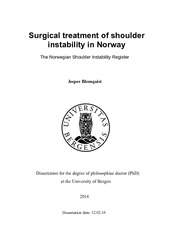| dc.description.abstract | Shoulder dislocation affects approximately 1300 person per year in Norway. The dislocation is normally caused by a fall on the outstretched arm. Many of the patients develop chronic recurrent instability, where the shoulder joint re-dislocates during sport activity or daily living. Other patients experience habitual chronic instability without an initial trauma. The current thesis has evaluated the surgical treatment of shoulder instability using data from the Norwegian Shoulder Instability Register that was established as a part of the project. The results are published in three papers. In Paper I we reported that the annual incidence rate of shoulder stabilisation surgery was 12 per 100.000 inhabitants. Compared to the annual incidence of shoulder dislocations approximately 40% of the patient with a primary dislocation underwent surgery. Anterior instability accounted for 83% of the procedures whereas posterior and multi-directional instability constituted 10% and 7% respectively. An arthroscopic labral repair (Bankart) was performed in 88% of the patients with primary anterior instability. In revision cases an open technique was used for 50% of the patients and coracoid transfer (Latarjet) was the dominating technique performed with an open approach. There was a significant improvement of the functional score for all patient groups. Primary anterior Bankart had a 1-year outcome of 75% on the WOSI score and a recurrence rate of 10%. Patients with posterior instability had a slightly worse WOSI score at follow-up (63%), and a recurrence rate of 16%. In Paper II we investigated if postoperative prescription of non-steroid anti- inflammatory drugs, NSAIDs, had any effect on the outcome after arthroscopic Bankart. In total only one third of the patients were treated with NSAIDs in the postoperative phase. The outcome for patients treated with and without NSAIDs did not differ after a mean follow up of 21 months. WOSI score was 75% and recurrence rate 12% for patient with NSAID treatment. For the control group the corresponding figures were 74 and 14%. Reoperation rates were 5% in both groups. 43% of the patients treated with an arthroscopic Bankart had an ambulatory procedure. 54% of the outpatients had non-steroid anti-inflammatory drugs, NSAIDs, prescribed post-operatively, compared to 19% of the inpatients. The result implies that postoperative use of NSAID in moderate dosages does not affect the outcome of arthroscopic Bankart and that it may facilitate ambulatory surgery. In paper III the outcomes of arthroscopic Bankart and open Latarjet were compared. After a mean 2.7 years follow-up we found a significantly higher recurrence rate of 17% after arthroscopic Bankart, compared to 7% after open Latarjet. There was a significant improvement but no difference between the treatment groups in the functional outcome, with a WOSI score of 74% for arthroscopic Bankart and 75% for Latarjet. Patients with recurrence of instability did not improve their score. Item analysis of the WOSI score indicated that patient with a Latarjet felt more secure on the stability of their shoulder, but had a lower score on mobility. In multiple logistic regression analysis the risk of recurrence after arthroscopic Bankart was further emphasised, with an odds ratio (OR) of 12.8 (CI 95%: 1.45-113, p=0.002). Age below 20 years at time of surgery was a risk factor for recurrence after both procedures (OR 2.24, CI 95%: 1.36-3.69, p=0.002). A combination of glenoid bone loss and an engaging Hill Sachs lesion was a risk factor for recurrence after arthroscopic Bankart (OR 12.6, CI 95%: 1.61-98, p=0.014), but not after a Latarjet procedure. WOSI for revision patients was 67% for arthroscopic Bankart and 65% for Latarjet at follow-up, with recurrence rates of 24 vs. 17%. WOSI-score was significantly lower for revisions compared to primary procedures (p<0.05), but there was no statistical significant difference between the two techniques. This thesis supports previous studies that have shown a high recurrence rate after arthroscopic Bankart. The Latarjet procedure had significantly fewer recurrence events, despite a higher proportion of patients with bone loss. Still, there was no difference in the functional outcome, indicating that there may be other drawbacks with this treatment. Patients with bone loss, especially when present on both the humerus and glenoid, seem to profit on treatment with a Latarjet procedure. Patient below 20 years of age has a poor prognosis for both treatment options. | en_US |
| dc.relation.haspart | Paper I: Blomquist J, Solheim E, Liavaag S, Schroder CP, Espehaug B, Havelin LI. Shoulder instability surgery in Norway: the first report from a multicenter register, with 1-year follow-up. Acta Orthop. 2012 Apr;83(2):165-70. The article is available in BORA at: <a href="http://hdl.handle.net/1956/11863" target="blank">http://hdl.handle.net/1956/11863</a> Paper II: Blomquist J, Solheim E, Liavaag S, Baste V, Havelin LI. Do nonsteroidal anti- inflammatory drugs affect the outcome of arthroscopic Bankart repair? Scand J Med Sci Sports. 2014 Dec;24(6):e510-514. The article is available in BORA at: <a href="http://hdl.handle.net/1956/8830" target="blank">http://hdl.handle.net/1956/8830</a> Paper III: Blomquist J, Solheim E, Liavaag S, Havelin LI. Arthroscopic Bankart versus Latarjet for anterior shoulder instability. Manuscript submitted. The article is not available in BORA. | en_US |
